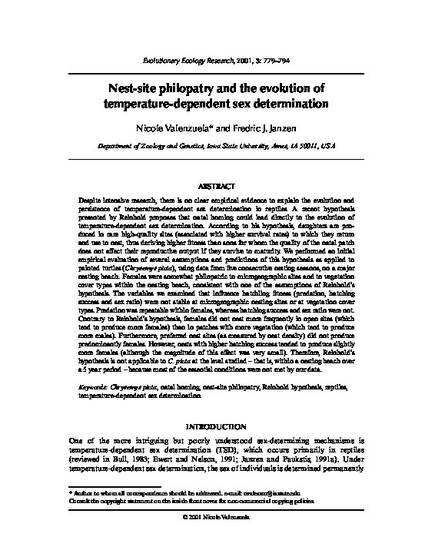
Despite intensive research, there is no clear empirical evidence to explain the evolution and persistence of temperature-dependent sex determination in reptiles. A recent hypothesis presented by Reinhold proposes that natal homing could lead directly to the evolution of temperature-dependent sex determination. According to his hypothesis, daughters are produced in rare high-quality sites (associated with higher survival rates) to which they return and use to nest, thus deriving higher fitness than sons for whom the quality of the natal patch does not affect their reproductive output if they survive to maturity. We performed an initial empirical evaluation of several assumptions and predictions of this hypothesis as applied to painted turtles (Chrysemys picta), using data from five consecutive nesting seasons, on a major nesting beach. Females were somewhat philopatric to microgeographic sites and to vegetation cover types within the nesting beach, consistent with one of the assumptions of Reinhold’s hypothesis. The variables we examined that influence hatchling fitness (predation, hatching success and sex ratio) were not stable at microgeographic nesting sites or at vegetation cover types. Predation was repeatable within females, whereas hatching success and sex ratio were not. Contrary to Reinhold’s hypothesis, females did not nest more frequently in open sites (which tend to produce more females) than in patches with more vegetation (which tend to produce more males). Furthermore, preferred nest sites (as measured by nest density) did not produce predominantly females. However, nests with higher hatching success tended to produce slightly more females (although the magnitude of this effect was very small). Therefore, Reinhold’s hypothesis is not applicable to C. picta at the level studied – that is, within a nesting beach over a 5 year period – because most of the essential conditions were not met by our data.
Available at: http://works.bepress.com/fredric-janzen/3/

This is an article in Evolutionary Ecology Research 3 (2001): 779. Posted with permission.